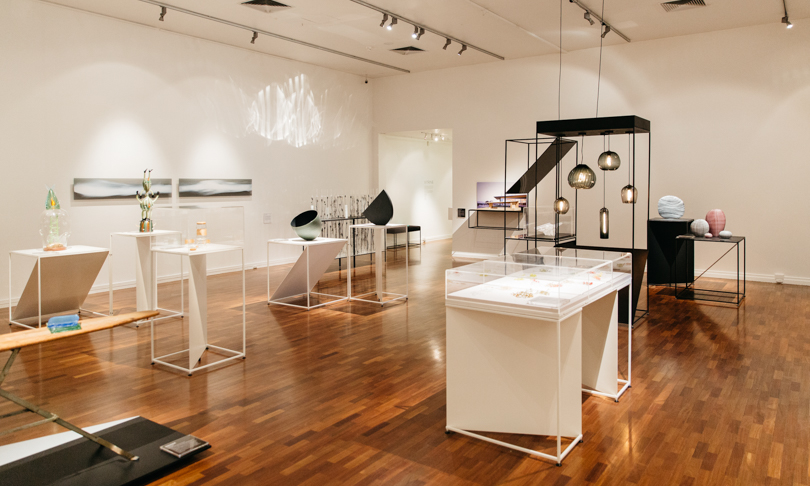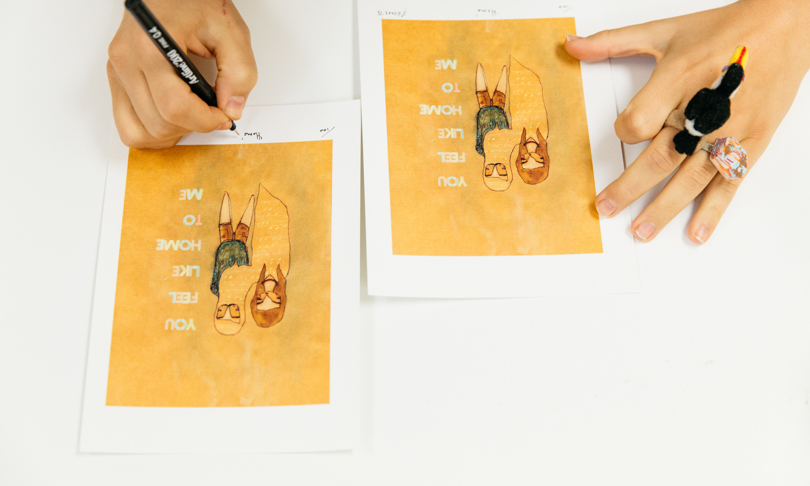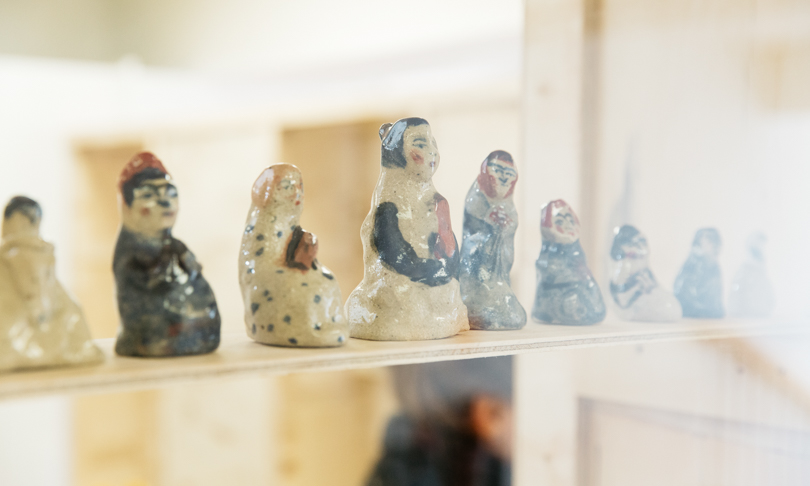In an economy that values things more than thoughts and a country where arts funding is rapidly decreasing, trading your creativity for cash is increasingly difficult. Despite this, a few Adelaide institutions and individuals are forging ahead with new ways of making a buck from making art.
Show me the Monet: Art and business
When artists with the enormous international profiles of Taylor Swift and Nicki Minaj are complaining about income from album sales, it becomes blazingly evident that something is broken in the relationship between creative output and economic reward.
The internet has disrupted almost everything, and its content-sharing capacity has bred a generation of humans – now entering adulthood – for whom things like music, film, TV, photography, writing and even objects d’arte have been available for free, or very cheaply.
In such an environment, those who pursue a career in art are bound to struggle. The traditional user-pays model has collapsed and everyone along the value chain is in trouble. Meanwhile, in Australia specifically, it is becoming less politically palatable to give money to artistic causes. The Federal Government dialled down arts funding by more than $100 million in the 14/15 budget, and has announced a further $100 million will be reallocated away from funding body the Australia Council in the coming year.
“Both China and Europe see art as a fundamental part of who they are and recognise its economic value,” says Joe Hay – a former advisor on the arts to SA Premier Jay Weatherill and now a consultant working in the field of ‘innovative change’.
“Australians, at best, might recognise art’s cultural value, but in my experience convincing people of its economic potential is difficult – most people see it as a colourful add on.”
With the Federal Government backing away from traditional support models, the State Government has been left considering its options. Arts SA – the department responsible for the creative industries – has recently been folded into a new mega-bureaucracy called the Department of State Development.
This move has been broadly interpreted as a signal that art and artists will now be considered an industry in SA, rather than a target for taxpayer charity.
It might sound like a harsh manoeuvre with the potential to stub out creativity in favour of commercial nous, but Joe says it could have the opposite effect – building an industry structure in which artists can find financial safety without dedicating energy to searching for it.
“If people don’t see the value in the art, it doesn’t mean there’s no actual value,” he says. “There is a need for business to translate our art into commercial outcomes. Government can help do this through the services it already provides other industry sectors. SA is a global leader in a number of artistic fields and we can commercialise the arts in the same way we do other globally competitive products.”
Of course, many artists possess both the skills to make art and the skills to spruik that art’s unique value. But for those who don’t, the transitional period we are in presents a problem – particularly as governments begins to refocus funding on creating systems that make artists sustainable rather than continuing with once-off grants.
Several Adelaide institutions have begun to create models that redress this problem by forging new connections between artists and those who can support them.
Recently, one of Adelaide’s most respected creative organisations – JamFactory – launched its first official philanthropy program, the Medici Collective.
CEO Brian Parkes says the not-for-profit has always worked hard to fully exploit all of its commercial potential, but is now ready to look at new ways to support the training and development arm of its operations.
“The organisation, throughout its history, has always been fairly entrepreneurial. What that entrepreneurialism has done is it’s insulated us quite well,” he says.
“We never want to diminish the value or our commercial and retail brand… But at the same time, its success is not going to diminish our belief in what we deliver in terms of public good for the creation of a better cultural eco-system.
“The training program that we offer has a huge impact on the national creative economy, because the people that go through this two year program come from everywhere and go all over the place. We think that’s something that people should invest in, if they want to see good things happen.”
Asking for philanthropic donations is an old idea, but the JamFactory’s Medici project is specifically positioned to encourage a new method of giving.
Instead of asking for large lumps of money to be donated by a few, JamFactory are hoping to establish a larger group who offer a modest donation to them as part of a “portfolio of giving” that might cover everything from hospitals to libraries. This way, they can tap into pools of people who have an interest in supporting what Brian calls a “richer society”, rather than just those interested in the arts.
In promoting the Medici Collective idea, they’ve also strived to paint a different picture of how the money will be used.
“I think at the moment people aren’t necessarily wanting to back talent, they’re wanting to back success,” says JamFactory development manager Nikki Hamdorf.
“A lot of the imagery we’ve used in the past has been, I guess, the ‘starving artist’ look. But I think there’s now a lot of investors that need a touch point – and you can see this in the Medici collateral – to see how artists are being trained to become successful entities in their own right.
“That’s part of the artists’ training too – to know how to portray themselves to attract the right attention.”
At the time of writing, the Medici project has attracted strong support, with “about 30” philanthropists having signed on.
The importance of showing a return on investment for philanthropy has also been picked up on by Guildhouse – another organisation with a long history in helping artists develop sustainable practices.
Recently concluding its 50 for 50 campaign, Guildhouse was aiming to raise $50,000 in this, their 50th year of operation, in order to start an interest-free loan scheme for practitioners. Modelled on similar schemes that have been rolled out in Queensland, the program offers investors the chance to see their money help multiple artists as it is loaned out, paid back and loaned out over and over again.
The 50 for 50 campaign further differs from other philanthropy programs by not offering a guarantee of where the money will be spent. Instead, philanthropists contribute to the large funding pool, which is made available to artists via application for almost anything – whether it be equipment purchase, further study, research, or any number of other things.
“They don’t know what the exact outcome is when they donate, but they hopefully are donating because they like the philosophy behind it,” says Guildhouse program manager Megan Rainey.
“The understanding is that it will benefit artists, not just once it’s loaned but when it’s re-paid and loaned again. Our fifty thousand dollars, once it’s loaned twice then becomes a hundred thousand dollars. It’s just perpetual like that.”
Most of the 50 for 50 funding was sought through philanthropic networks, but a small percentage – just $5000 – was called for through crowdfunding website Pozible. Additionally, every dollar raised by Guildhouse was matched by the Creative Partnerships Australia PLUS 1 Program.
Guildhouse executive director Rae O’Connell says they were only looking for limited crowdfunding contributions so as to limit pressure on the very community they are trying to help.
“We didn’t want to ask artists to give other artists money,” she says.
“We’re really targeting the foundations and individuals and corporates, we need that diversity – we’re getting in touch with them using a lot of help from our board. It’s really important those organisations invest in the artists – it gives them the freedom and space to experiment and fail. That’s how great work develops.”
Beyond philanthropy and loan schemes, there are other pockets of innovation that tackle the problems with artistic viability by reducing barriers rather than injecting funds.
Brick and Mortar Creative – a new intitiative from Elizabeth Donaldson and Brigid Dighton – is designed specifically to mitigate risk for artists and designers looking to make the leap into retail.
“I think grants and philanthropy are brilliant as far as giving you that start-up capital or supporting different elements of your creative practice that may not necessarily be so marketable,” says Elizabeth.
“What we’re trying to do here is have a platform that provides you with a sustainable model to test the market without taking the risk of having to mortgage the house or something.
“So, we thought, how about if we worked with the concept of having a lot of different things in the same place. With the experience economy rising, we can have people coming in to do various things… they want to come in to grab a coffee and do a workshop, as well as meet the maker and interact with them, maybe buy something and know that you’re supporting local because you can see the creative process happening.”
Under their model, Elizabeth and Brigid have absorbed most of the risk of retail business by signing a commercial lease for a large space in Norwood themselves. They offer little sections of the space out to makers, who have the opportunity to set up miniature retail shops and see how the market reacts without paying high overheads.
A café, gallery and workshops also operate in the space to help cover rent and attract more people into the space.
As they’ve worked to establish this incubator for creative practitioners, the pair has found help flowing in from unusual places. The City of Norwood, Payneham & St Peters – their landlord – is one of their biggest supporters, offering rent subsidies for the building that Brick and Mortar occupies. Local business Haymes Paint also donated the supplies needed to renovate the space, and signwriter Ian Widdup of Ecept will be creating all their signage free of charge.
In seeking this support to set-up the “social enterprise” that is Brick and Mortar on a limited budget, Elizabeth and Brigid found that one of the most important things was being able to show people how the idea would not only support artists, but also reach out more broadly.
“When people looked at the concept and saw it was basically a multi-functional space, they were really keen to come aboard,” says Brigid.
“They were very interested in how it was about creative community building and about making creative activity much more accessible to the broader community.”
The importance of proving wide resonance in seeking support is something that experimental Adelaide sound artist Jason Sweeney has experienced directly. He is now working on the third installation of his quiet trilogy – a series of projects exploring the importance of quiet experiences. The first installation of the trilogy, Stereopublic, received international attention and significant financial support thanks to its participatory potential.
“Stereopublic was so important to me because that was the project that really got all this interest and I still have people sending me submissions for that everyday,” he says of the work that asked people to record quiet places in their cities and submit them to Jason, who plotted them onto city maps that were publicly accessible via an app.
“Other projects I’ve done since don’t have that level of interest. So, it’s about thinking about what you’re tapping into that makes people engage – what is it about the project? Is there maybe only one project like that in your lifetime?”
Attracting finance to develop the third part of the trilogy – a performance work called Silent Type that is likely to be quite long (about 60 hours) and possibly quite challenging (very quiet) – is proving much more difficult. Jason has run a crowd-funding campaign through the Australian Cultural Fund, is in talks with private investors and is making grant applications. All of this has been an uphill battle because of the abstract and conceptual nature of the work.
Despite this, he feels compelled to persist with Silent Type because he sees value in it as a creative endeavour.
“I just feel completely driven to create these experiences of stillness and quiet,” he says. “From a musician point of view it’s where I’ve been led… This is the perfect end to all the work I’ve done in quietness – it’s an abstract and physical experience of finding a kind of quiet that you won’t get from going into an alleyway or something like you might do in Stereopublic.
“I’m also interested in an experience that is not necessarily just about the optimistic aspect of the quiet experience. There will always be moments of silence that are used to honour certain events, they’re part of day-to-day life but what if it’s an experience where we don’t quite know why we’re being quiet, why we’re being silent, why we’re having that experience together?”
The challenges Jason faces in funding Silent Type lie at the heart of the issue.
Jason is an artist who is perfectly capable of garnering support for his projects and commercialising his skills – as proven by the success of Stereopublic and the vast array of commission work he does for organisations like Closer Productions and the State Theatre Company. The new models of arts funding and support like those canvassed here will help upskill artists to be more like Jason, but there will remain a gap where support for the conceptual projects that bring depth to Australia’s arts should be.
Further innovation is needed to tackle this problem, but perhaps the solution can be found in the same place as the root cause. Ideas like Kevin Kelly’s 1000 True Fans theory – in which creative practitioners seek regular financial input from a small group of dedicated supporters – are most easily executed in the internet age.
And while alternative models of wresting money from the recipients of creativity are still in flux, the work of places like JamFactory, Guildhouse and Brick and Mortar will bring artists that little bit closer to making a living out of making.














